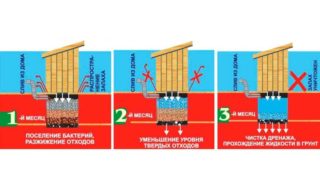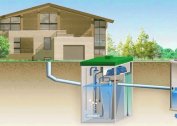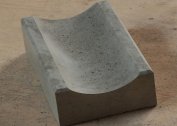For an autonomous sewage device, not only a pipeline is needed, but also an end sink receiver. More often it is a sealed septic tank or cesspool. The first is a complete local treatment system and works like a clock. The second version of the tank often gives the master a lot of problems. Especially if cesspools fill up quickly after pumping out. To troubleshoot, you need to find out the cause of the failure.
Causes of the problem
To find the root of the malfunction of the drain receiver, you need to understand its structure and learn the principle of operation. As a rule, a cesspool is dug simply in the ground. In the best case, its walls are laid out with brick, and the bottom is made drainage (sand, gravel, but). In such a receiver, water just oozes into the ground, and feces (large impurities) remain, forming a viscous slurry. She later needs to be pumped out with a sewage machine.
In the worst case, a cesspool is just an earthen cube into which drains flow. This version of the receiver device is unacceptable, because fecal water cause irreparable harm to the environment. In addition, the walls of the earthen pit are silted faster and are overgrown with fat.
The main reasons for quickly filling the receiver may be as follows:
- Tank volume too small. For example, the pit was originally designed for two people with a specific number of water consumption, and more recently, a dishwasher or washing machine was added from plumbing fixtures, and two more guests began to live in the house.
- Siltation of the bottom. Both the earthen pit and the receiver with the drainage bottom become silted over time. In the first case, this happens faster, such as fecal masses, domestic waters contain human burns. They first settle with a thin film on the bottom and walls of the tank, making it difficult for the outflow of clarified liquid to flow into the ground. The thicker the film of fat, the faster the pit will fill. The same goes for receiver walls.
- Frozen soil in the winter. If the soil at the bottom of the pit is grabbed by ice, water will not go into it freely. From this comes the quick filling of the waste chamber.
In order not to harm the environment, not to provoke outbreaks of epidemics in the village, it is advisable to make a cesspool with sealed walls and a bottom. In addition, it is interpreted by the sanitary standards of the Russian Federation.
Effective Solutions
Eliminate the problem of quickly filling the sewer pit sequentially, depending on the cause. If you need to increase the volume of the tank, it is not necessary to dig a separate new receiver. You can form an additional overflow chamber next to the first one for 1/2 of the total volume of the old pit. Thus, the system will look like a full-fledged septic tank. The main thing is to bring the overflow window into the second chamber and arrange a drainage bottom in it. Later, fecal matter will be less likely to be pumped out of the first receiver.
Siltation of walls and bottom
This problem is fought like this:
- Flushing sludge on the bottom and walls of the receiver. Will have to work with household appliances. Do this after pumping the pit and under high pressure. Everything washed off must be removed from the receiver again.
- Complete replacement of the draining bottom. All stones, rubble and sand should be removed here. Then re-lay the drainage layer.
At the time of washing out the grease film, it is advisable to thoroughly treat the walls of the pit and the bottom with hard brushes.
 Also, to combat body fat, you can use special preparations:
Also, to combat body fat, you can use special preparations:
- Bacteria.The drugs in this series are living cultures that come into action in a humid environment. Bacteria actively decompose fecal effluents into organic sludge and plain water. The main advantage of using such drugs is that the stench completely disappears, and the receiver has to be pumped out less often. In addition, sludge later becomes organic compost. But it is worth remembering that bacteria work only at a plus temperature of +7. If there is household chemicals in the water (powder, detergent, etc.), the bacteria reduce their activity or cease to act at all. The most popular biological products for cesspools are Microbec, Vodograi.
- Chemical substances. The main component of such drugs is ammonium compounds, formaldehydes or nitrate oxidizing agents. Chemicals are extremely aggressive, and therefore effectively affect fatty impurities in fecal waters. But they have a number of their own characteristics. Formaldehyde products are considered the most dangerous for the environment. They completely destroy odors, pathogenic bacteria, fats, but when they get into the ground they completely kill all living things in the soil. On dead ground for 7-8 years nothing will grow. Fruits that have already ripened on such soil cannot be eaten. Ammonium chemicals can only be used in the warmer months at plus temperature. Preparations based on nitrate oxidizing agents are considered the most environmentally friendly. The sludge formed from their work is suitable as compost.
When using any drugs, it is highly advisable to adhere to recommendations regarding loading dosages per hole.
Frozen soil
If the reason that the cesspool is gaining quickly is frozen soil, you need to take measures to eliminate the problem:
- Warm up the pipeline completely. To do this, from the outlet of the collector from the house to its entrance into the pit, it is worth stretching the electric cable. It is advisable to do this even at the stage of installation of the sewer system. An additional insulation is laid on top of the cable.
- The bottom of the receiver, frozen from below, will have to be heated with special iron rods. One metal rod exceeding the depth of the pit in height is driven into the bottom with force so that one end sticks out from above. A stripped electric cable is thrown onto the rod and connected to the network. The principle of such heating is that the frozen earth conducts current well, due to which it warms up. Thawed soil does not allow electricity further.
To heat one pit with a volume of 3 m3 in this way will take at least a day.
Prevention of rapid filling of a sewer pit
 To avoid problems with fast filling of the receiver in this way:
To avoid problems with fast filling of the receiver in this way:
- At the stage of the device pit should correctly calculate its volume. Additionally, you can throw another 20%.
- It is important to consider the depth of soil freezing in the area. If you can’t position the pit below this level, you need to qualitatively insulate the camera. Additionally, you will have to take care of a possible warming up of the collector.
- It is better to mount a septic tank immediately or at least completely concrete the walls / bottom of the receiver. This will protect the soil from the negative effects of runoff and prevent siltation in the tank.
- In the warm season, it is better to use bacteria. They will not only remove layers of fat on the walls and bottom of the pit, but also eliminate unpleasant odors. In addition, pumping can be carried out less frequently.
- Once a year, it is advisable to thoroughly rinse the walls and bottom of the leaky pit.
You should regularly monitor the dynamics of filling the sewer tank and pump out fecal wastewater on time.




